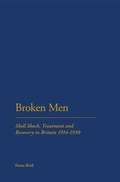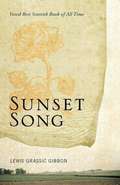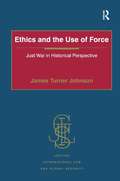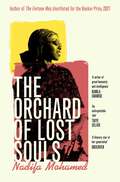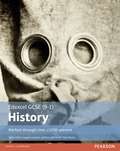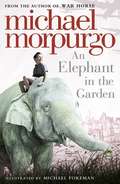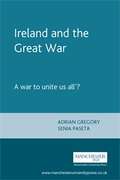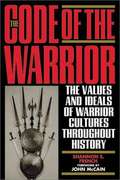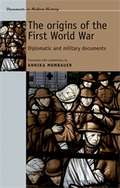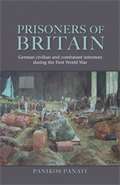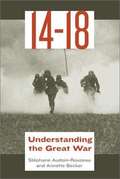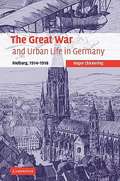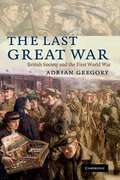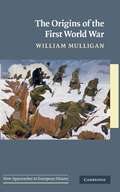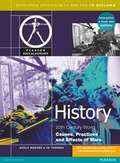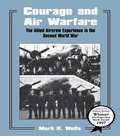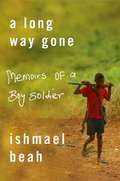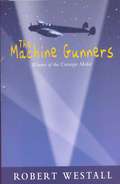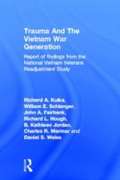- Table View
- List View
Broken Men: Shell Shock, Treatment And Recovery In Britain, 1914-1930 (PDF)
by Fiona ReidShell shock achieved a very high political profile in the years 1919-1922. Publications ranging from John Bull to the Morning Post insisted that shell-shocked men should be treated with respect, and the Minister for Health announced that the government was committed to protecting shell-shocked men from the stigma of lunacy. Yet at the same time, many mentally-wounded veterans were struggling with a pension system which was failing to give them security. It is this conflict between the political rhetoric and the lived experience of many wounded veterans that explains why the government was unable to dispel the negative wartime assessment of official shell-shock treatment. There was also a real conflict between the government's wish to forget shell shock whilst memorialising the war and remembering the war dead. As a result of these contradictions, shell shock was not forgotten, on the contrary, the shell-shocked soldier quickly grew to symbolise the confusions and inconsistencies of the Great War. HB: 9781847252418 PB: 9781441148858
Meter and Oscilloscope symbols (UEB Uncontracted)
by Rnib BookshareThis page shows IEC (International Electrotechnical Commission) symbols for a voltmeter, an ammeter, a galvanometer, an ohmmeter, and an oscilloscope. There is a locator dot shown, which will be at the top left of the page when the image is the correct way up. The symbols are on the left of the page and the descriptive labels are on the right.
Meter and Oscilloscope symbols (UEB Contracted)
by Rnib BookshareThis page shows IEC (International Electrotechnical Commission) symbols for a voltmeter, an ammeter, a galvanometer, an ohmmeter, and an oscilloscope. There is a locator dot shown, which will be at the top left of the page when the image is the correct way up. The symbols are on the left of the page and the descriptive labels are on the right.
Switch Symbols (Large Print)
by Rnib BookshareThese pages show IEC (International Electrotechnical Commission) symbols for a push switch, a push-to-break switch, an SPDT on/off switch, an SPDT 2-way switch, a DPDT dual on/off switch, a reversing switch, and a relay. This is a multi-page document with images on two pages. There is a locator dot shown, which will be at the top left of the page when the image is the correct way up. The symbols are on the left of the page and the descriptive labels are on the right.
Switch Symbols (UEB Contracted)
by Rnib BookshareThese pages show IEC (International Electrotechnical Commission) symbols for a push switch, a push-to-break switch, an SPDT on/off switch, an SPDT 2-way switch, a DPDT dual on/off switch, a reversing switch, and a relay. This is a multi-page document with images on two pages. There is a locator dot shown, which will be at the top left of the page when the image is the correct way up. The symbols are on the left of the page and the descriptive labels are on the right.
Switch Symbols (UEB Uncontracted)
by Rnib BookshareThese pages show IEC (International Electrotechnical Commission) symbols for a push switch, a push-to-break switch, an SPDT on/off switch, an SPDT 2-way switch, a DPDT dual on/off switch, a reversing switch, and a relay. This is a multi-page document with images on two pages. There is a locator dot shown, which will be at the top left of the page when the image is the correct way up. The symbols are on the left of the page and the descriptive labels are on the right.
Sunset Song (PDF)
by Lewis Grassic GibbonSunset Song is the first and most celebrated of Grassic Gibbon's great trilogy, A Scot's Quair. It provides a powerful description of the first two decades of the century through the evocation of change and the lyrical intensity of its prose. It is hard to find any other Scottish novel of the last century which has received wider acclaim and better epitomises the feelings of a nation.
Ethics And The Use Of Force: Just War In Historical Perspective
by James Turner JohnsonHighlighting the just war tradition in historical perspective, this valuable study looks at contemporary implications drawn out in the context of several important contemporary debates: within the field of religion, including both Christian and Islamic thought; within the field of debate related to the international law of armed conflicts; within the field of policy relating to the use of armed force where the issue is just war thinking vs. realism; and debates over pressing contemporary issues in the ethics of war which cross disciplinary lines. James Turner Johnson has been writing on just war tradition since 1975, developing the historical understanding of just war and seeking to draw out its implications for contemporary armed conflict. He is frequently asked to lecture on topics drawn from his work. This current book brings together a number of essays which reflect his recent thinking on understanding how and why just war tradition coalesced in the first place, how and why it has developed as it has, and relating contemporary just war reasoning to the historical tradition of just war.
The Orchard Of Lost Souls
by Nadifa MohamedThe eagerly awaited new novel from the author of the acclaimed Orange-longlisted Black Mamba Boy. It is 1988 and Hargeisa waits. Whispers of revolution travel on the dry winds but still the dictatorship remains secure. Soon, and through the eyes of three women, we will see Somalia fall. Nine-year-old Deqohas left the vast refugee camp she was born in, lured to the city by the promise of her first pair of shoes. Kawsar, a solitary widow, is trapped in her little house with its garden clawed from the desert, confined to her bed after a savage beating in the local police station. Filsan, a young female soldier, has moved from Mogadishu to suppress the rebellion growing in the north. And as the country is unravelled by a civil war that will shock the world, the fates of the three women are twisted irrevocably together. Intimate, frank, brimming with beauty and fierce love,The Orchard of Lost Soulsis an unforgettable account of ordinary lives lived in extraordinary times. 'As these three women's stories entwine, the result is a moving and captivating tale of survival and hope in a war-torn country, and confirms Mohamed's stature as one of Britain's best young novelists' Stylist 'Three women watch, and suffer, as their native Somalia descends into brutal civil war. It's 1988. The atrocities pile up, but the authorial voice remains resolutely melodic' Vogue 'With the unadorned language of a wise, clear-eyed observer, Nadifa Mohamed has spun an unforgettable tale. The Orchard of Lost Soulsrecounts not just a state's descent into war, but war's most heartbreaking human toll: the death of dreams' Taiye Selasi, author of Ghana Must Go
Edexcel GCSE (9-1) History, Warfare Through Time, C1250-present (PDF)
by Paul Shuter John ChildExam Board: Edexcel Level: GCSE Subject: History First teaching: September 2016 First exams: Summer 2018 Series Editor: Angela Leonard This Student Book: covers the essential content in the new specification in an engaging way, using detailed narrative, sources, timelines, key words, helpful activities and extension material uses the 'Thinking Historically' approach and activities to help develop conceptual understanding of areas such as evidence, interpretations, causation and change, through targeted activities has 'Writing Historically' features that focus on the writing skills most important to historical success. This literacy support uses the proven Grammar for Writing approach used in many English departments includes lots of exam guidance, with practice questions, sources, sample answers and tips to support preparation for GCSE assessments. * These resources have not yet been endorsed. This information is correct as of 31st July 2015, but may be subject to change. You do not have to purchase any resources to deliver our qualification.
An Elephant In The Garden (PDF)
by Michael MorpurgoA thrilling and moving novel about an extraordinary animal caught up in a very human war, for anyone who loved The Amazing Story of Adolphus Tips or The Butterfly Lionâe¦ By the award-winning former Childrenâe(tm)s Laureate and author of War Horse. Dresden, 1945. Elizabeth and Karli's mother works at the zoo, where her favourite animal is a young elephant named Marlene. Then the zoo director tells her that the dangerous animals âe" including the elephants âe" must be shot before the town is bombed. Unable to give Marlene up, their mother moves her into the back garden to save herâe¦ and then the bombs start to fall. Their home destroyed, the whole family must flee the bombed-out city and through the perilous, snow-covered landscape, all the while avoiding the Russian troops who are drawing ever closer. It would be hard enough to do, without an elephant in towâe¦
Ireland And The Great War: 'a War To Unite Us All'? (PDF)
by Adrian Gregory Senia PasetaAs the twentieth century drew to a close, people in all parts of Ireland began to recover the memory of the First World War as the last great common experience of the island as a whole. Brings together research whilst re-evaluating older assumptions about the immediate and continuing impact of the war on Ireland. Explores some lesser-known aspects of Ireland's war years as well as including studies of more traditional areas: military, social, cultural, political and economic aspects. Analyses how the experience and memory of the War have contributed to identity formation and the legitimisation of political violence.
The Code Of The Warrior: Exploring Warrior Values Past And Present (PDF)
by Shannon E. French John MccainThis volume comprises selected texts from nine warrior cultures, ancient and modern. The texts are organized around four questions: Why do the warriors fight? How do they fight? What brings them honor? and What brings them shame? It argues that the answers members of the warrior cultures give to these questions reveal a great deal about what their values really are; whether they believe in human rights and human dignity; their views on sacrifice, duty, and obligation; and their understanding of the meaning of life.
The Origins Of The First World War: Diplomatic And Military Documents (PDF)
by Annika MombauerThis book is a unique collection of diplomatic and military documents which illuminate the origins of the First World War. It brings together newly-discovered archival sources as well as documents not previously available in English, drawn from a broad range of sources and countries. It is an essential collection for anyone studying the origins of the First World War. The volume contains several hundred international documents for the years 1911-1914, selected because they are vital to understanding the origins of the war. The volume includes a comprehensive scholarly introduction which analyses the most controversial issues in the debate on the origins of the First World War on the eve of the centenary. It also provides a detailed overview of the history of official document publications on the diplomatic background to the outbreak of war, and places these within the context of the long historiographical debate on its origins. The First World War continues to fascinate scholars, students and the general public, and the riddle of its origins has never been satisfactorily solved. Anyone studying the outbreak of the war will find this collection indispensible. Documents are an essential tool for historical study, particularly for this controversial topic about which historians have argued for the best part of a century. The documents in this volume are thoroughly cross-referenced and annotated, and presented with authoritative commentary. This allows readers to make connections between the documents to illuminate how the decisions for war were made, and why.
Prisoners Of Britain: German Civilian And Combatant Internees During The First World War (PDF)
by Panikos PanayiDuring the First World War hundreds of thousands of Germans faced incarceration in hundreds of camps on the British mainland. This is the first book to be published on these German prisoners, almost a century after the conflict. This account concentrates both upon the bureaucratic decision to introduce internment and the consequences of this government policy for individual lives. The book covers the three different types of male internees who found themselves behind barbed wire in Britain between 1914 and 1919 in the form of: civilians already present in the country in August 1914; civilians brought to Britain from all over the world; and combatants, primarily soldiers from the Western Front, but also naval personnel and a few members of zeppelin crews, whose vessels fell to earth. Using a vast range of contemporary British and German sources, including both the official record and the accounts of numerous internees, the volume traces life experiences through initial arrest and capture to life behind barbed wire to return to a defeated Germany or the remnants of the ethnically cleansed German community in Britain. The study questions the necessity of incarcerating hundreds of thousands of men but places this decision into wider developments in British and European society, bureaucracy and minority persecution. This fascinating volume will prove essential reading for anyone interested in the history of prisoners of war or the First World War and will also appeal to scholars and students of early twentieth century Europe and the human consequences of war.
14 - 18: Understanding The Great War (PDF)
by Stephane Audoin-Rouzeau Annette Becker Catherine TemersonWith this brilliantly innovative book, Stéphane Audoin-Rouzeau and Annette Becker have shown that the Great War was the matrix on which all subsequent disasters of the twentieth century were formed. Three elements of the conflict, all too often neglected or denied, are identified as those that must be grasped if we are to understand the war: First, what inspired its unprecedented physical brutality, and what were the effects of tolerating such violence? Second, how did citizens of the belligerent states come to be driven by vehement nationalistic and racist impulses? Third, how did the tens of millions bereaved by the war come to terms with the agonizing pain? With its strikingly original interpretative strength and its wealth of compelling documentary evidence drawn from all sides in the conflict, 14-18: Understanding the Great War has quickly established itself as a classic in the history of modern warfare.
The Great War And Urban Life In Germany: Freiburg, 1914-1918 (PDF)
by Roger ChickeringIn deference to the principle that total war requires total history, Roger Chickering traces the all-embracing impact of the First World War on life in the German city of Freiburg. His book shows how the war took over every facet of life in the city, from industrial production to the supply of basic material resources, above all food and fuel. It documents the breakdown of distinctions between the home front and the fighting front, as the city fell victim to strategic bombing. It analyzes the war as a sensory experience, which could be seen, heard, felt, smelled, and tasted as it exhausted the city, drained it of residents, and eroded civic bonds among those who remained. Roger Chickering offers the most comprehensive history ever written of a German city at war. The book will appeal to urban and military historians, as well as to social and cultural historians.
The Last Great War: British Society And The First World War (PDF)
by Adrian GregoryWhat was it that the British people believed they were fighting for in 1914–18? This compelling history of the British home front during the First World War offers an entirely new account of how British society understood and endured the war. Drawing on official archives, memoirs, diaries and letters, Adrian Gregory sheds new light on the public reaction to the war, examining the role of propaganda and rumour in fostering patriotism and hatred of the enemy. He shows the importance of the ethic of volunteerism and the rhetoric of sacrifice in debates over where the burdens of war should fall as well as the influence of religious ideas on wartime culture. As the war drew to a climax and tensions about the distribution of sacrifices threatened to tear society apart, he shows how victory and the processes of commemoration helped create a fiction of a society united in grief.
The Origins Of The First World War (PDF)
by William MulliganProviding a new interpretation of the origins of the First World War, this textbook synthesises recent scholarship and introduces the major historiographical and political debates surrounding the outbreak of the war. William Mulligan argues that the war was a far from inevitable outcome of international politics in the early twentieth century and suggests instead that there were powerful forces operating in favour of the maintenance of peace. His fresh perspective on the pre-war international system takes account of new approaches to the study of international politics since the end of the Cold War and the acceleration of globalisation. Thematic chapters examine key issues, including the military, public opinion, economics, diplomacy and geopolitics, and analyse relations between the great powers, the role of smaller states, the disintegrating empires and the July crisis. This compelling account will significantly revise our understanding of diplomacy, political culture, and economic history from 1870 to 1914.
Pearson Baccalaureate: Causes, Practices and Effects of Wars for the IB Diploma (PDF)
by Keely Rogers Jo ThomasThree student books with complete coverage of the most popular history topics. Causes, Practices and Effects of War Authoritarian and Single Party States Cold War Each of these 20th Century World textbooks provides: A clear overview and analysis of key leaders and events. Thematic approaches, comparative studies, cross-regional perspectives and explanations of the methods of historical research and writing. Timelines, document-based activities, practice questions, essay practice and sample answers. Free online resources to support and extend study at www. pearsonbacconline. com.
Courage and Air Warfare: The Aircrew Experience in World War II
by Mark K. WellsColonel Wells investigates the nature of aerial warfare and the men who took part. The book analyzes aircrew selection, reaction to combat, adaptability to stress, morale, leadership and combat effectiveness, and compares the efforts of the US Eighth Air Force and RAF Bomber Command.
A Long Way Gone: Memoirs Of A Boy Soldier (PDF)
by Ishmael BeahMy new friends have begun to suspect I haven't told them the full story of my life. "Why did you leave Sierra Leone?" "Because there is a war. " "You mean, you saw people running around with guns and shooting each other?" "Yes, all the time. " "Cool. " I smile a little. "You should tell us about it sometime. " "Yes, sometime. " This is how wars are fought now: by children, hopped-up on drugs and wielding AK-47s. Children have become soldiers of choice. In the more than fifty conflicts going on worldwide, it is estimated that there are some 300,000 child soldiers. Ishmael Beah used to be one of them. What is war like through the eyes of a child soldier? How does one become a killer? How does one stop? Child soldiers have been profiled by journalists, and novelists have struggled to imagine their lives. But until now, there has not been a first-person account from someone who came through this hell and survived. In A Long Way Gone, Beah, now twenty-five years old, tells a riveting story: how at the age of twelve, he fled attacking rebels and wandered a land rendered unrecognizable by violence. By thirteen, he'd been picked up by the government army, and Beah, at heart a gentle boy, found that he was capable of truly terrible acts. This is a rare and mesmerizing account, told with real literary force and heartbreaking honesty.
The Machine Gunners (PDF)
by Robert WestallChas McGill is living in WWII Britain. He has the second-best collection of war souvenirs, only rivalled by Boddser Brown. Chas wants to beat Boddser more than anything, and his search for the ultimate souvenir leads him into the woods where he finds a crashed German bomber-with its machine gun still attached. All Chas has to do is remove the gun, then not only will he beat Boddser hands down, but he can play a real role in the war effort. . .
Trauma And The Vietnam War Generation: Report Of Findings From The National Vietnam Veterans Readjustment Study (PDF)
by Richard A. Kulka Alan CranstonFirst published in 1990. Routledge is an imprint of Taylor & Francis, an informa company.
Trauma And The Vietnam War Generation: Report Of Findings From The National Vietnam Veterans Readjustment Study
by Richard A. Kulka Alan CranstonFirst published in 1990. Routledge is an imprint of Taylor & Francis, an informa company.
